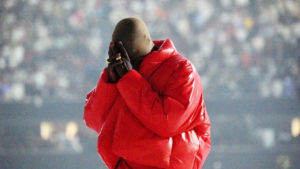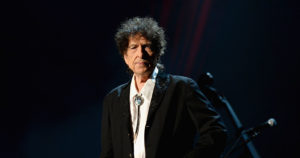Nick Cave defies rock music’s law of gravity. A few weeks ago I went to see Cave and the Bad Seeds headline All Points East in Victoria Park, London and came away thinking it was the best I’d ever seen them, but then I often think that. In terms of range, chemistry, intensity and sense of occasion, the Bad Seeds are, I believe, the greatest live band in the world.
Earlier in the summer I saw the Rolling Stones in Hyde Park and that was a good night out but nobody in their right mind would claim that the Stones are better now than they were in 1969 or 1973. Yet the best time to see the Bad Seeds, who formed in 1983, is right now. Though Cave is about to turn 65, the refinement of his craft has required no ebbing of conviction. When he inhabits a murderer on Death Row in “The Mercy Seat”, or a mad prophet retelling the birth of Elvis Presley in “Tupelo”, he still goes all in. The quasi-industrial brutality of “From Her to Eternity” is as persuasive as the naked pleading of “I Need You”. When I went back to the studio versions over the following days, I found them somehow lacking by comparison. Between songs, Cave radiated warmth and good humour. Most frontmen pick a moment to commune with the crowd from the edge of the stage but I suspect Cave could have happily spent the whole show down there, arms outstretched.
Until I read Cave’s new book, Faith, Hope and Carnage, I found it hard to put my finger on why the Bad Seeds have become so much more potent and popular in recent years. Their only Top 20 entry is “Where the Wild Roses Grow”, a 1995 duet with Kylie Minogue. Two of their most popular songs on Spotify, “Red Right Hand” and “O Children”, owe their position to appearances in Peaky Blinders and Harry Potter. Many of their live highlights weren’t even singles, let alone hits. Since the creative nadir of Nocturama in 2003, the Bad Seeds have enjoyed a series of rebirths: the explosive maximalism of Abattoir Blues/The Lyre of Orpheus, the slower, subtler Push the Sky Away and the lambent prayers of Ghosteen.
That last transformation was enforced. Seven years ago, Cave’s 15-year-old son Arthur died after falling from a cliff near Brighton. Cave’s grief was etched into Ghosteen and its predecessor Skeleton Tree, the making of which was chronicled in Andrew Dominik’s gently shattering 2016 documentary One More Time with Feeling. This incomprehensible tragedy suddenly became the signal fact of Cave’s life. “The loss of my son defines me,” he says in the book.
After a period of necessary privacy, Cave chose to make his grieving public. In 2018 he started answering questions from fans on his website under the name “The Red Hand Files” and on the road with his “Nick Cave in Conversation” events: an experiment in radical transparency and fostering a community of the bereaved. The first entry in The Red Hand Files was about how he resumed songwriting after tragedy. “Creative people in general have an acute propensity for wonder,” he wrote. “Great trauma can rob us of this, the ability to be awed by things. Everything loses its sheen and appears beyond our reach. We were surviving, but we were surviving in exile on the perimeter of our lives, way beyond anything that mattered.” His lifelines were “work and community” — a means of connecting with the suffering of others in order to feel less alone.
As you can tell, Cave is one hell of a writer. As the author of countless spectacular lyrics, two novels, an epic poem and an unproduced screenplay (a berserk take on a Gladiator sequel), he could surely write a classic memoir but Faith, Hope and Carnage is something else: a series of conversations with his friend Seán O’Hagan, an Observer journalist. Kudos to O’Hagan for having the idea and Cave for running it because it’s an extraordinary, one-of-a-kind book. An alternative title might be God, Grief and Art.
Cave may claim to hate interviews but he is a miraculously fluent talker, incapable of a dull line. Many of the sentences have an aphoristic punch. Creating art is “the act of retelling the story of our lives so that it makes sense”. Hope is “optimism with a broken heart”. Twitter is “just a factory that churns out arseholes”. On lyrics: “A dishonest line tends to deteriorate somehow after repeated singing; a truthful line collects meaning.” On death: “If you have been fortunate enough to have been truly loved, in this world, you will also cause extraordinary pain to others when you leave it.”
Cave’s songs have always been saturated with religious imagery and language — first the Old Testament, later the New — but it was never clear how much of a believer he was. Now, he says, he is emphatically religious in the sense of feeling a “deep inclusion in the human predicament”. That sounds just like Leonard Cohen, another great songwriter whose wisdom derived from an idiosyncratic relationship with the divine and an underrated sense of humour. To call this a self-help book would horrify everyone involved but I suspect many readers will find it useful, especially those who have known catastrophic grief.
Cave describes the loss of his son as nothing less than an annihilation of the self. He has been broken to pieces and remade — born again, you might say. His songwriting, too, has required reassembly. He considers Skeleton Tree, mostly written before Arthur’s death but recorded afterwards, as an “unholy” record which he struggles to revisit. But making Ghosteen, via long improvisatory sessions with Ellis, was a “holy” experience in which his son’s spirit felt literally present. “Arthur was snatched away, he just disappeared, and this felt like some way of making contact again and saying goodbye,” Cave says. Over the course of these conversations, which began with lockdown in March 2020, there are other losses: his mother Dawn, his ex-lover Anita Lane, his friend Hal Willner and, most recently, his oldest son Jethro. Covid-19 gives the book an eerie backbeat.
O’Hagan is a sensitive interviewer — really more of a conversationalist. Cave says that he finds relating his own history “unbearable, mostly”. What’s more, it feels to him like someone else’s life — that of a man who had not yet lost his son. So why look back?
Still, O’Hagan occasionally manages to lure Cave into the past. His idyllic, outdoorsy childhood in Wangaratta, Australia, gave way to a delinquent adolescence, which was blown apart by the death of his father, a teacher of literature, in a car accident when Cave was 19. He was already taking heroin, an addiction that he relates, perhaps surprisingly, to a conservative need for routine rather than the thirst for chaos that animated his music for many years. After the hellfire post-punk of the Birthday Party came the Bad Seeds. Cave remarks that Mick Harvey and Blixa Bargeld, band mainstays from the beginning until the 2000s, were domineering personalities like himself. “The potential for disharmony is enormous! It’s like having Hitler, Stalin and fucking Mao Zedong trying to make a record together.” Warren Ellis, who joined in 1997, is more like a brother: an equal partner in the studio and a remarkable friend. On the topic of friendship, Cave’s affection for Coldplay’s Chris Martin is delightfully unexpected. “Obviously, there’s a fair amount of daylight between the kinds of music we play, but who fucking cares? I have always been drawn to his generosity of spirit, his engagement with the world.”
When he was younger, Cave thinks, he had too much disdain for the world. Now it inspires awe. He cherishes humility, mercy and mystery; he loathes dogma, cynicism and the morally obvious. He is therefore stronger than most on the subject of cancel culture, to which his objection is more personal than political. He recoils from the punitive impulse; the failure of empathy and forgiveness. I would argue that forgiveness needs to be sought and earned but I think he’s right to say that the online ritual of denunciation can be merely “a kind of sadism dressed up as virtue”. I hope this section doesn’t get clickbaited as “Cave slams cancel culture!” because it’s more about the particular view of human nature that he has arrived at: “I rarely see badness in people; rather, I see layers of suffering.”
The context is obvious. Towards the end of the book, Cave finally talks about the night of Arthur’s death, and how he and his “astonishing and oceanic” wife Susie negotiated the immediate aftermath. Hard to read, it must have been infinitely harder to speak, but emotional availability is essential to everything he does now. The most common question submitted to The Red Hand Files, apparently, is “Does it ever get better?” To which Cave can now reply: “The answer is yes. We become different. We become better.” Instead of being diminished by loss, he has been enlarged. “I became a person after my son died” is a startling line.
It is impossible to overstate how unusual it is to find this depth of self-analysis and wisdom from a rock musician. Faith, Hope and Carnage makes most rock memoirs look like skips full of rusty anecdotes and grudges. Among other things, the book finally helped me understand why Cave and the Bad Seeds keep getting better. Cave’s growing hunger for “communal awe” makes the shows feel genuinely necessary. And he believes himself to be a more generous and expansive person than he was before, so he has more to give.
“We’re often led to believe that getting older is in itself somehow a betrayal of our idealistic younger self, but sometimes I think it might be the other way around,” he tells O’Hagan. “Maybe the younger self finds it difficult to inhabit its true potential because it has no idea what that potential is.” He knows now.
***
This article was first published on 21 September 2022.
Disclaimer
Some of the posts we share are controversial and we do not necessarily agree with them in the whole extend. Sometimes we agree with the content or part of it but we do not agree with the narration or language. Nevertheless we find them somehow interesting, valuable and/or informative or we share them, because we strongly believe in freedom of speech, free press and journalism. We strongly encourage you to have a critical approach to all the content, do your own research and analysis to build your own opinion.
We would be glad to have your feedback.
Source: UnHerd Read the original article here: https://unherd.com/





